How to Make a DIY Chicken Dust Bath Area
If you want happy chickens, this article on how to DIY Chicken Dust Bath area for Your Chickens is just what you need.
When raising chickens, your goal is to keep them healthy and happy so you get fresh eggs daily. This DIY project is easy and an important part of your chicken coop.
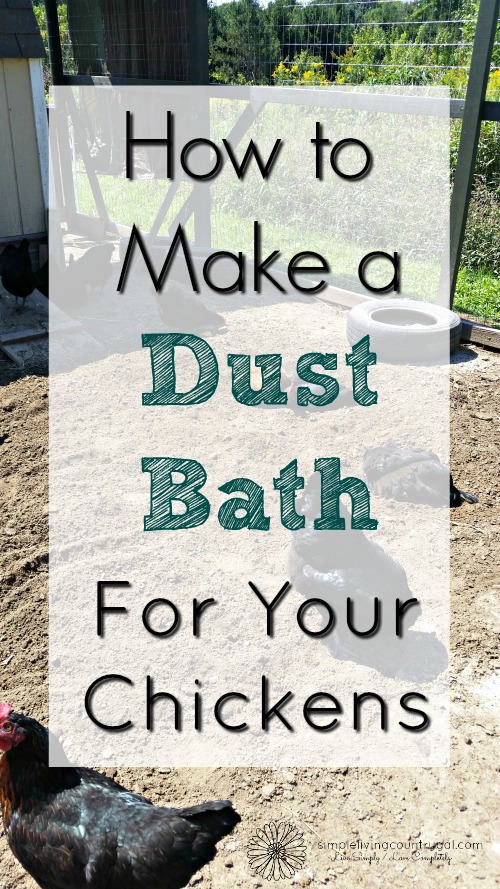
When I first started raising chickens, I knew nothing. Not….. A…..Thing Every day was a learning experience, and my chickens were the teachers.
I remember one day going out to check on my chickens, and I found a hen lying on the ground using her feathers to throw dirt up all around her. I had no idea what she was doing but stood watching her for some time, marveling.
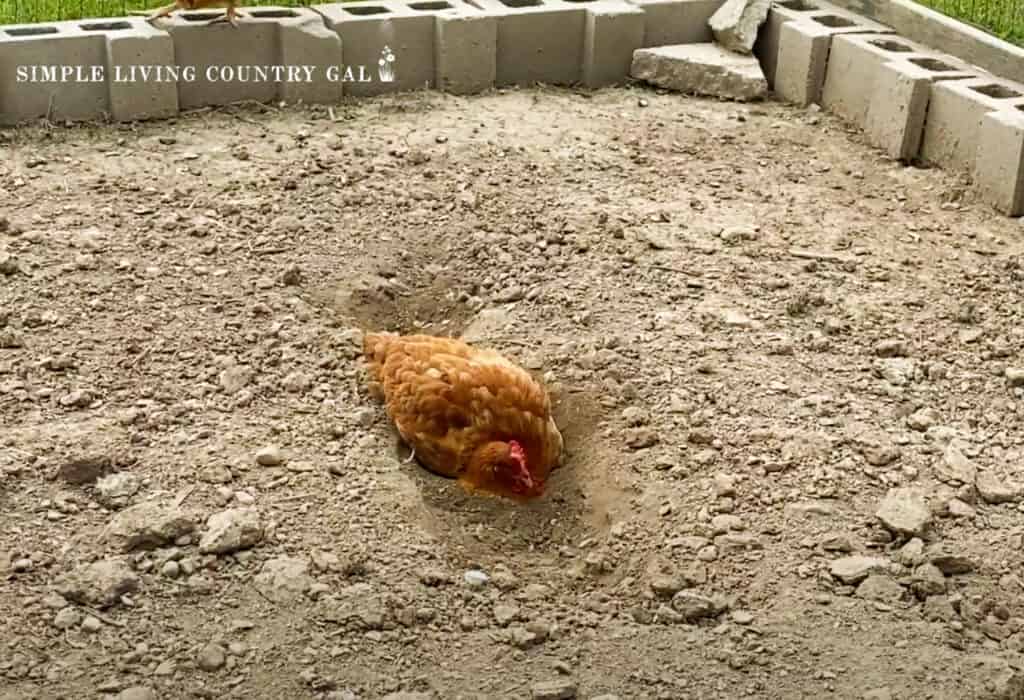
She was lying on her side, tossing loose soil all over herself, causing a small cloud of dust to bubble up around her as she did. She then stayed still for the longest time, napping in the soil in the sun. Suddenly, she jumped up, shook all the dirt out, and walked off just as happy as could be.
I found out later that what she was doing was taking a bath, chicken style. Yes, a bath with dirt. Just another reason why I love raising chickens in my backyard.
I later did some research and learned that the addition of a dust bath to my chicken run was necessary not only to promote the health of my flock but to create a calm environment as well. It is really important to have a calm and protected atmosphere for your hens. This will help to deter henpecking.
What is henpecking?
Hen pecking is when one or more chickens “bully” a weaker hen. They chase, squawk, and in some cases, attack the hen. If not stopped, it can lead to injury or even death. Let me say that this is a scary thing to witness if you are a new chicken owner.
You can read my post, Thinning out the Flock, to learn more about this and what you can do to prevent it.
To reduce tension in a coop, you will want to add things for your hens to do that will decrease boredom this will go a long way to keeping your flock from picking on other and weaker hens.
If you are new to chickens, dust bathing may sound like a crazy idea. Do chickens like to bathe themselves? And in the dust? Seriously? Yes, they not only enjoy it, they need it.
Chickens find dust bathing very comforting, so much so that when they finish, they pass out, sometimes even on their sides or backs.
I cannot even tell you how frightening it was for me the first time I saw a hen on her back sleeping in a pile of loose soil. My hens sleep so soundly that many times, even now, I need to walk up to a dust bath napper (Say that 3 times fast) to check and make sure she is just sleeping.
The ritual can be quite comical when you first see a chicken dust-bathing.
How a Chicken Takes a Dust Bath
First, the hen will dig a shallow hole, loosening up the dirt by scratching at the ground with her feet. This part can take quite a while, and the hen will enjoy it so much she tends to do more than one area before settling on the very best spot.
She will then lie down in the loose soil, kicking and tossing the dirt all over herself and into her feathers. She will continue to do this repeatedly, resting in between each roll and toss. Eventually, she will shake all the dirt out (a show in itself) and off, only to finally settle down and take a long nap in the hole.
Why do Chickens Take a Dust Bath?
Dust bathing, also known as dirt bathing, is an ingrained act; even baby chicks will attempt to dust-bathe in their brooders. I have never added a dust bath for my babies, but I know others have with good success.
Chickens take dust baths as their way of keeping clean. By tossing dirt or sand into their feathers, they help to free themselves from pests. Pests that can invade chicken coops, such as lice or mites.
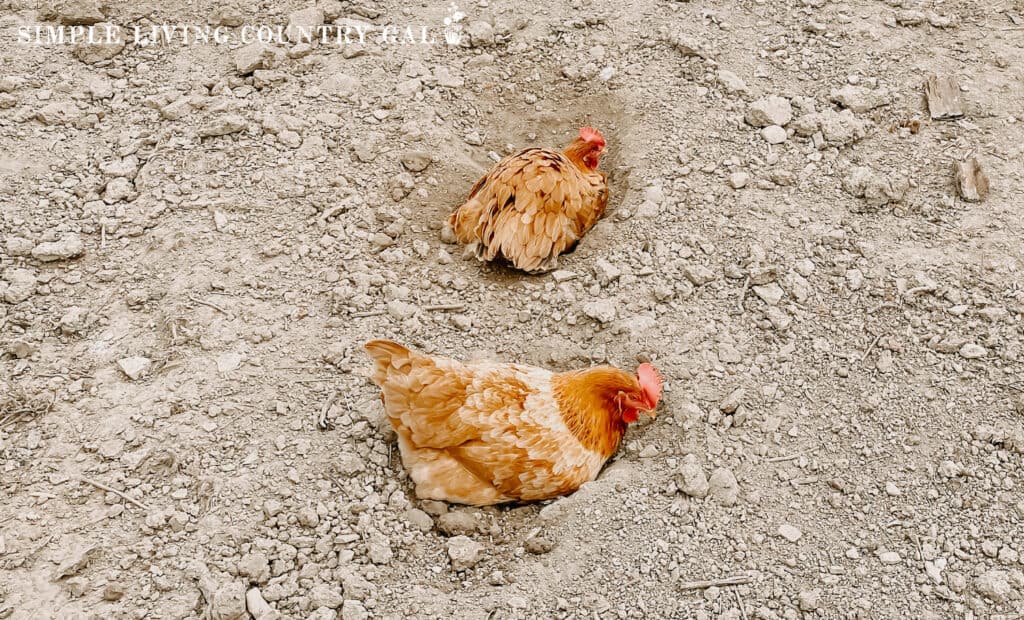
Why are dust baths so beneficial?
Chickens have glands that secrete oils. Over time, excess oils and dead skin can build up, creating the perfect home for parasites. When a hen tosses loose dirt through her feathers, she dries up the excess oils and removes debris, dead skin, and parasites. This leaves the chicken feeling clean and refreshed.
If your outdoor area (chicken run) is small, you may want to create a specific spot for your gals to bathe in. This can be easily done (and quite inexpensively) with a dishpan, litterbox, or even old tires, as I did in our own chicken coop.
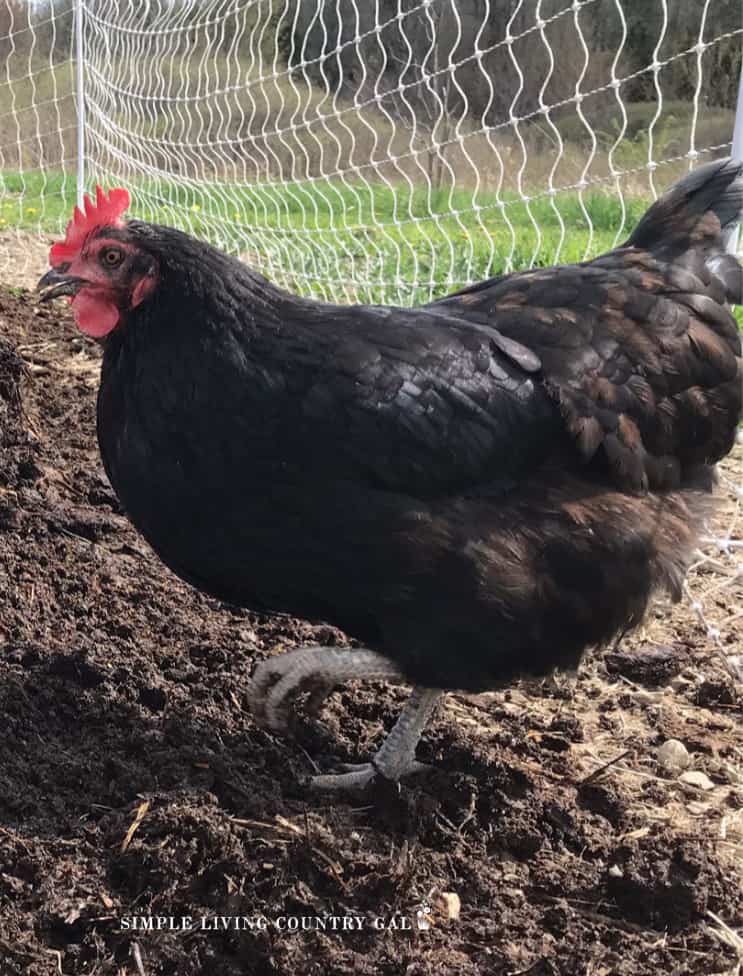
Check around the house for anything large enough to hold a hen but shallow enough for her to get into without tipping it over.
How To DIY Old Tires Into A Chicken Dust Bath.
Even though there are many options you can use as a dust bath container, this guide will be using tires. Mainly because so many homesteads tend to have a few lying around waiting to be used.
World’s Best Chicken Bath – Wood Ash, Sand, Dust – for All Chickens (2 Pounds)


Step #1. Clean Your Tires
Gather up any old tires that you may have lying around. For our flock of 20, I had four tires, and that number seemed to work quite well. Next, give them a good cleaning being sure to remove any debris that may negatively affect your chickens.
You can do this with soapy water and a stiff scrub brush. Be sure there is nothing on the outside or the inside rim of the tire that may harm your chickens.
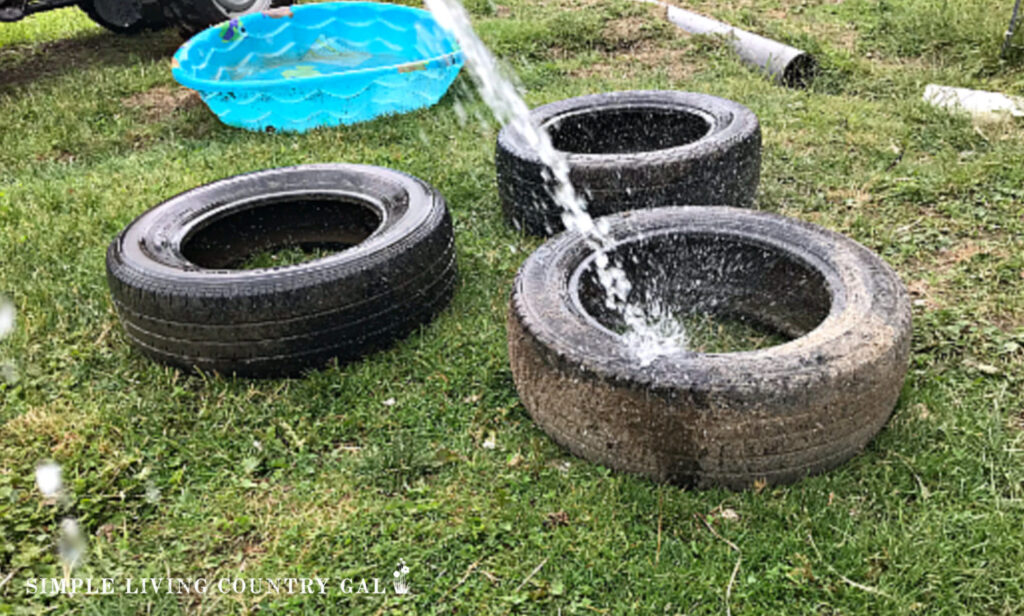
Step #2. Allow Them to Dry
Once the tires are washed and rinsed, you can allow them to dry in the warm sunshine. Sun acts as a natural sterilizer that will disinfect your tires while allowing them to dry rather quickly.
Step #3. Paint
Since tires are black painting them white might be an option to consider. The white will help keep them from getting too hot in the sunshine once they are out in your chicken run. I also like the white color as it adds some personality to an otherwise dull chicken run.
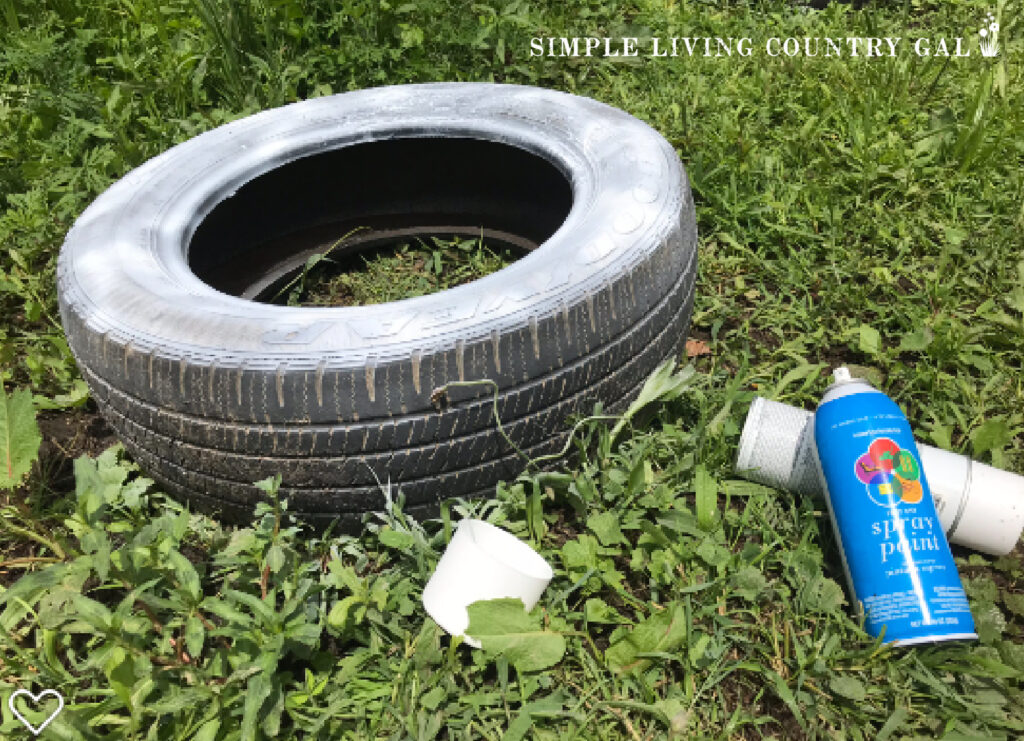
What is a good container for a dust bath?
We love to use tires but there are many things you can use for a dust bath container. A good depth to look for is about 12 inches deep.
A few ideas are:
- Wash tub
- Litter box
- Trash can lid
- Cardboard box
- Kiddie pool
- Plastic sandbox
- Large feed bowl
- Old tire
Remember, the purpose of the container is to keep the materials in place so the chickens do not kick things away while they are bathing. Also, if your dust bath is outside, try to place it in an area where it will not get wet. If this is not an option, you will want to have a cover to help keep the material inside dry.
Step #5. What to Put Inside
Once your dust bath container is ready, it’s time to fill it up. The ingredients you add will all play an important role in dust bathing. Be sure to only use dry ingredients that are fine enough to get in between the feathers.
The most common ingredients found in a chicken dust bath are:
- Soil – great for chickens to scratch in while they are bathing.
- Sand – be sure it is fine so it doesn’t clump.
- Wood Ash – helps to absorb toxins from pores.
- Wood Chips – try to find fine wood such as shavings if possible.
- Diatomaceous Earth – helps remove pests and parasites.
- Herbs – helps with odor and relaxes your hen.
It is not necessary to add in all that is suggested; remember soil is all you need for an effective dust bath.
Dust Bath for your Chickens – the Supplies:
- A sturdy container that will hold up in weather and is large enough for 1-2 hens at a time, such as a plastic washtub, shallow tote, or even old tires, will work great.
- Loose dirt – This will work as the base for your chicken’s dust bath and is the most common ingredient found.
- Bathing sand – This will help keep the materials inside your DIY dust bath loose so that it doesn’t clump up.
- Wood ash – This will help to remove any pests found in your hen’s feathers. A little goes a long way. Be sure to never use wood ash from bricks or any that was started with lighter fluid.
- Food Grade Diatomaceous Earth – This will help to deter ticks, lice, and other pests that can affect the health of your flock. DE is a great addition to any farm or homestead as it has many beneficial uses.
Directions for your DIY chicken dust bath:
- Location – Place your bath in an area that is easily accessible for your hens. More than one is a good idea if you have a large flock. You are looking for a nice sunny spot in the spring but not in the heat of the sun during the summer. This is why a portable chicken dust bath is so nice. You can move it depending on the season and the weather.
- Protect – If you cannot find a location sheltered from the elements, such as heavy wind or rain, you may want to create a lid to help keep the contents dry. I use a square board or old trash can lid for our chickens. These both do the job quite nicely.
- Mix the base – Combine in equal parts the sand and dirt mixing with your hands to incorporate them all together.
- Add in extras – This will be about 1 cup DE (Diatomaceous Earth) and a few cups of wood ash (these amounts depend on the size of your bath)
Stand back and enjoy!
Remember, if you are building an outside chicken dust bath, you will want to make sure you have something to cover your dust bath at night, and during rainy times I have found if the materials inside get wet, it can take forever for things to dry out.
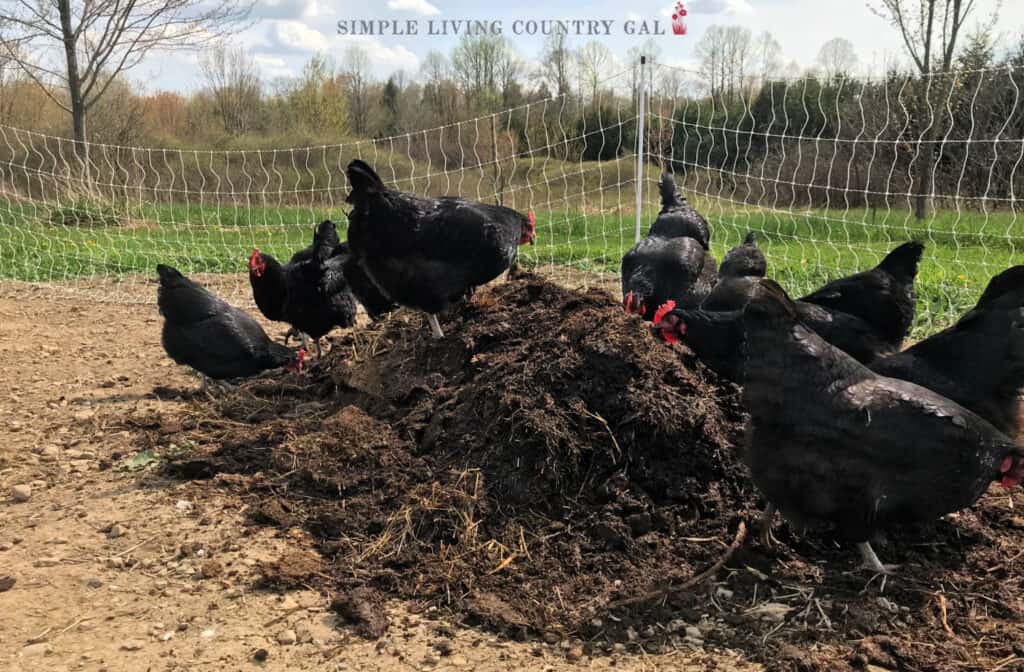
You can use just about anything as a cover.
- Trash can lid
- Wooden board
- Tarp
- Plastic tote lid
SLCG PRO TIP: If you use Diatomaceous Earth, be sure it is food grade. Some folks warn against DE in dust baths believing it may damage the bird’s lungs if used in large amounts. I have not had a problem with this, but I want you to know the warnings are just the same. If you choose not to use DE, don’t worry, the dust/sand/ash will do the job just fine.
READ: HOW TO USE WOOD ASH ON THE HOMESTEAD
What if you do not have room for a separate dust bath?
Not all chicken runs have room for a DIY dust bath, so here are a few extra options you can use to add to an area without sacrificing some of your run or chicken coop.
Take the time to loosen up some of the soil in your chicken run a few times a year. You can do this with a shovel taking scoops out and turning the soil over. You do not need to break up any dirt clumps either; your chickens will enjoy doing that as they search for worms and other treats in the overturned soil.
You can also use a rototiller and either work on the entire run or just a small area inside. As time passes, a chicken run can get very hard and compacted down. The goal is to loosen up the soil so your chickens can first scratch out any treats and then use the loosened soil for bathing in.
I like the low-cost method of simply rototilling up an area in the run to loosen the dirt. This was how we did a dust bath area for our hens for many years. This will give your hens hours of enjoyment and stop boredom that can easily happen in a flock that is not free-ranging.
What is Free-Ranging?
Free-ranging means allowing your chickens to be loose during the day, allowing them to look for worms and other bugs around your yard and property. A note of caution if you choose to free-range your flock. Train them to come when called. This will help you get them inside the coop each evening, where it is safe from predators.
You can train your chickens or any livestock animal to come when called through consistent training.
Each time you are out to feed your hens, shake a bucket of grain and give them a call.
Be sure to use the same tone of voice and words when you do.
After a short while, they will understand that your voice and that call means food and will come running from all over to eat.
What if my chickens won’t use their dust bath?
Don’t worry if your chickens ignore your new dust baths. Chickens are not quite as curious as, say, goats or cows. Something new in the coop is not nearly as interesting as scratching for bugs or worms. Just give them time.
Yes, it may take a while for the hens to realize exactly what you have made for them, but don’t worry; before you know it, they will be bathing to their heart’s content!
Congratulations on adding another integral part of a healthy, happy chicken coop. Being proactive in your animal’s health and well-being is more cost-effective than waiting until you have a problem.
Not only will a DIY chicken dust bath area for your chickens provide health and happiness to your flock, but it will also give you hours of entertainment!

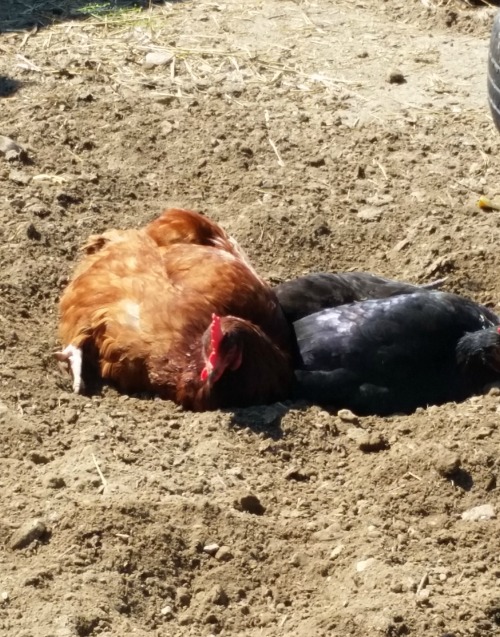




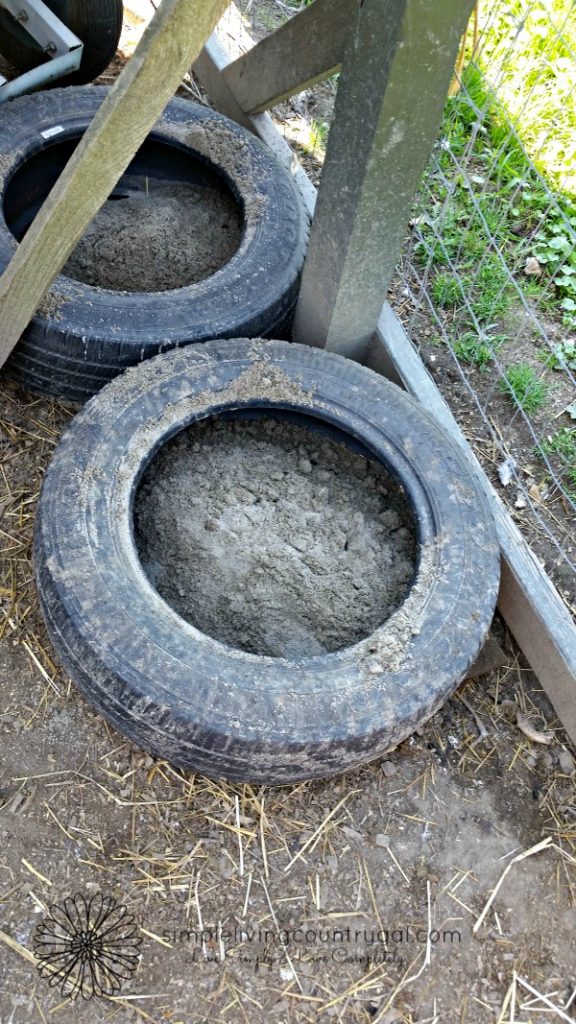


You say “Add about 1 cup DE and a few cups of wood ash” What is DE?
Hi there, Lisa!
DE is Diatomaceous Earth which is made from the fossilized remains of tiny, aquatic organisms called diatoms. It helps control parasites on chickens when they dust it into their feathers. Make sure to always use food-grade that can be found at any feed meal or Amazon.com as well.
Hope this helps!
Tracy Lynn
Thank you for all the great info. I am new to raising chickens, and I am so thankful for folks like you willing to share your knowledge. My question is, when you add wood ash to your baths, would it be harmful to use the ashes from our fireplace if we have used fire starters? We don’t use the starter logs, just the smaller blocks.
thank you
Hi, Susie,
I wish that question was easy to answer but it all depends. When using wood ash for your chickens a good rule of thumb is only to use ash from hardwoods. With that being said it really depends on the ingredients of your starter blocks. As long as the ingredients are all hardwood you will be just fine.
I hope this helps. And good luck with your new chickens!
Tracy Lynn
Very nice article, can’t wait to try it. Will start on it today.